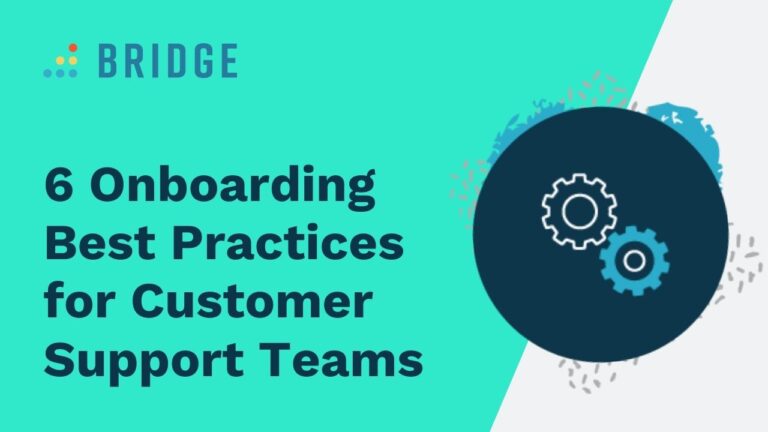Creating a memorable customer experience matters. At the heart of this experience is your customer support team. Often the most visible face of your company, they have enormous influence over customer retention and brand reputation.
According to a Salesforce report, 88% of customers consider the experience a company provides to be as important as its products and services.
Your customer-facing employees must be excellent communicators with in-depth product knowledge, empathy, and a mastery of your channels and tools. With so much to learn, a thorough and carefully-planned onboarding program is essential to set your people on the road to success.
Why an Effective Customer Support Onboarding Strategy Is Important
A 2021 study by ASAPP, EY, and the University of San Francisco investigated the impact of providing employees with suitable training. Of the customer support agents who strongly agree that their training sets them up for success:
- 92% are satisfied with their ability to help customers
- 88% are satisfied with their knowledge of systems
- 77% are satisfied with their support from management
Equipping new hires with the right tools and skills with a well-planned onboarding and training strategy will set your people up for success.
What to Include In a Customer Support Onboarding Strategy
An effective onboarding experience outlines expectations, creates connections with the team and organization, and delivers training on the products, policies, and strategies they’ll use to support customers.
New employees need support to integrate into your culture and learn the expected skills, systems, processes, and behaviors during this time.
Simplify the process and create successful outcomes with the following six steps:
1) Create Personalized Onboarding Journeys
An onboarding journey or workflow that guides new starters through the first months of their new job offers much-needed clarity at each step.
Break the journey into daily or weekly assigned tasks, including meetings, training courses, and links to tools or knowledge they need to access. It’s helpful to automate parts of the process and schedule meetings and training ahead of time—this way, employees are never unclear about what they should be doing.
Always check that new hires have access to internal communications, workflow tools, and instant messaging channels. This is especially important for remote and distributed employees as it gives them easy access to information and shows them where to turn with questions.
Throughout the journey, set up meetings with stakeholders that new starters will work alongside and heads of different departments that work closely with their team. Each meeting should teach them something new about their area of work and the larger organizational structure. If they can’t find space to meet with a busy leader or manager across the business, schedule pre-recorded welcome messages instead. Short, informal videos are a great way to showcase your company culture in a way that gives employees immediate access to key information.
DISCOVER WAYS TO PERSONALIZE THE JOURNEY | ‘How Personalized Learning Enhances Employee Skills Development’
2) Tie Individual, Team, and Organizational Goals to Training Objectives
Zendesk’s Customer Experience Report reveals that organizations with high-performing customer service and support teams are almost ten times more likely to have leaders who actively define customer experience goals and regularly monitor performance.
Onboarding is the perfect time to introduce individual and team goals, and show their role in driving business success. Connecting training to performance goals with measurable outcomes shows employees what’s expected of them and how their team supports the wider business.
Start with a high-level overview of policies, organizational structure, and brand values. After laying the groundwork, introduce more product-specific information and gradually add more detail about features and functionalities. At this stage, goals could focus on information retention.
Customer support agents also need extensive knowledge of processes and frameworks, such as escalation and resolution steps. As they progress through onboarding and put their knowledge into practice through roleplaying, introduce more specific metrics like number of resolutions or quality of support.
New employees should also be encouraged to discuss their personal development and the skills they want to build. They should meet with their managers during onboarding to define their career drivers and turn them into future goals.
RELATED READING | ‘How Learning and Performance Can Connect, Align, and Grow Your Organization’
3) Create a Practice Environment to Learn the Product
Gartner data shows that 75% of leaders consider “creating a seamless customer journey” as one of the top drivers of success. As a result, they’re increasing their investment in training and technology. Product knowledge plays a huge role in customer support success. Customer support employees must be experts in your products and services with the communication skills to translate their understanding to customers.
Hands-on training is an effective way to train new hires on your organization’s offering. Give them access to a sandbox or test account to familiarize them with the environment and to practice different scenarios they’re likely to encounter. Working through real emails and calls allows team leaders to review communication skills and check for tone and accuracy.
HOW ONE COMPANY REVAMPED ITS ONBOARDING TO INCREASE REVENUE | ‘Transamerican’s Success Story’
4) Make Onboarding a Team Effort
Teamwork and collaboration are crucial to facilitate learning and information sharing. According to Hubspot, more customer service and support leaders consider upskilling a priority in 2022 compared to previous years, with peer learning being the training method of choice.
Peer learning creates a personable and supportive environment for new employees to learn. More experienced team members who know the ins and outs of processes and workflows are well-placed to lend a helping hand and share insight that training alone might not cover. Connect new employees with your top performers to shadow calls and emails—daily exposure will give them a grasp of what the job looks like in action and the steps to take. They’ll also start to contextualize any jargon or language differences they’re unfamiliar with.
Most new starters will gain enough experience in the early weeks to incorporate mock calls into their training, allowing them to practice your frameworks and best practices, and access on-the-spot feedback. As new hires become more independent, team leaders and mentors should be on hand to remind them about policies and procedures, and guide them in the right direction.
TIPS TO ENCOURAGE SOCIAL LEARNING | ‘5 Great Ways to Encourage Social Learning In the Workplace’
5) Schedule Regular One-on-Ones
Communication is a must during onboarding, especially in the first weeks. Regular one-on-ones with team leaders, managers, or peers serve as touchpoints to discuss what new hires have learned, what the next steps look like, and to check that they understand everything.
By engaging in ongoing conversations, employees will never be in the dark about their performance. It’s helpful to discuss accomplishments, plan out the next steps, and tie the conversation back to goals. It’s also a good way to introduce expectations for future performance reviews.
Toward the end of the onboarding journey, managers should review performance progress. And once the formal onboarding process is complete, it’s good practice for managers to meet with employees weekly to catch up on the status of tasks, goals, and discuss development plans.
BEST PRACTICES FOR PRODUCTIVE ONE-ON-ONES | ‘One-on-One Meetings: How the Personal Touch Improves Workplace Performance’
6) Break Training Into Manageable Chunks
Employees have lots to learn in the first few months. Break training down into manageable chunks so they never become overwhelmed and are always aware of how everything they learn applies to their role.
Be mindful about how much information your courses provide—if there’s too much detail or concepts aren’t clearly explained, they won’t add value. Instead, break training into manageable chunks in engaging formats that communicate the essential information. After each module, give learners a chance to practice new skills and test knowledge with quizzes and practice scenarios.
Leverage different formats and tools to appeal to a wide variety of learning styles and preferences, such as virtual demos, meetings, and peer learning. All resources should be stored in a central location so employees can access any content when they need it.
HOW TO CREATE MEANINGFUL ONBOARDING | ‘Onboarding Remote Employees: A Strategy for Success’
Customer Support Onboarding and Training Steps
Use the following steps to outline what new employees can expect during their first months with your company:
Customer Support Onboarding During the First Week
In the first week, new hires should:
- Complete mandatory training
- Start email and call shadowing
- Review the onboarding plan with their manager
- Meet the team
- Get access to company tools and software
- Familiarize themselves with policies, procedures, goals, and organizational structure
- Complete daily training activities and test their knowledge
Customer Support Onboarding Within the First Month
In the first 30 days, new hires should:
- Shadow peers to observe email responses and calls, ideally every day
- Roleplay customer calls with peers
- Meet with their manager multiple times a week
- Get to know products and software
- Play out scenarios in a test account
- Schedule calls with leaders, peers, and stakeholders across the business
- Continue to complete daily training activities and test their knowledge
Customer Support Onboarding Within the Second Month
Within 60 days, new hires should:
- Discuss career drivers and goals with their manager
- Respond to customer calls and emails
- Review and update onboarding goals
- Discuss on-the-job feedback with their manager or peers
Customer Support Onboarding Month Three and Beyond
After 90 days, new hires should:
- Review accomplishments with their manager over the last 90 days
- Discuss career development and provide input on an employee development plan
- Work more independently to provide valuable advice and resolution to customers
- Meet with their manager once a week
- Participate in ongoing training to develop communication skills
Set Your New Hires Up for Success With Bridge
Equip your customer support employees with the knowledge, connections, and resources to succeed. Bridge gives you the power to build tailored onboarding programs that deliver personalized training, learn from peers, and put their knowledge to the test.
Control every step of the onboarding journey to integrate performance goals into the flow of work, keep managers connected, and give them the skills to achieve their career goals.
Reach out today to speak with one of our experts.




